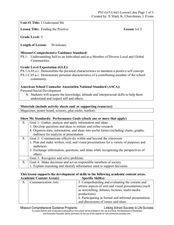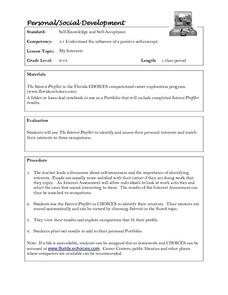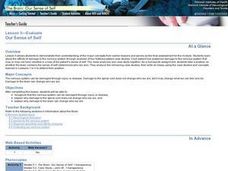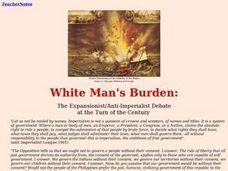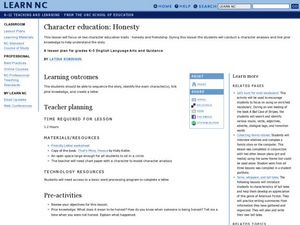Curated OER
Finding the Positive
Fifth graders meet the "Famous Artist." They are introduced to the topic of self-concept. Students work in small groups and get organized to create collages. They create a collage that represents characteristics of positive self-concept.
Teaching Tolerance
Identity Artifacts Museum
Who are you? It's a simple question, but younger learners have the opportunity to express their complex identities by making artifacts that represent parts of their identities. After engaging in the activity, they share who they are with...
Curated OER
I Like Me and I Like You
Students use the book "I Like Me!" to create a context for investigating self-concept (how one feels about self). They have the objective of realizing their rights and responsibilities. Students work in small groups conducting interviews...
Council for the Curriculum, Examinations and Assessment
Morals, Values and Beliefs
Your personality is based on the things you believe in, the morals you abide by, and the values upon which you make your decisions. Delve into a set of lessons about values and moral framework with your eighth graders as...
Facing History and Ourselves
The Costs and Benefits of Belonging
Peer pressure and the desire for acceptance are powerful things. A thought-provoking lesson looks at the positive and negative effects of wanting to belong to a group. Class members examine the roles of the perpetrator, the victim, the...
Curated OER
Personal/Social Development: My Interests
Students examine the influence of a positive self-concept. They identify and assess their own personal interests on an Internet Interest Profiler, and match occupations that fit their profile.
Facing History and Ourselves
Dual Identities
Many of us have multiple identities. There's who we are at home, school, friends, and strangers. And often these identities come with different names. The third activity in the First Days of School series examines how names reflect...
Curated OER
I Am Unique
Students list their unique characteristics. They interact in a positive manner in a group setting by determining and discussing each individual's uniqueness.
Little Stones
How Can Poetry Make People Think and Care?
Can beautiful words change the world? Literary scholars discover how to paint their visions of change using poetry in a series of three workshops. Each independent topic gives participants a chance to examine their feelings about...
Curated OER
Making Choices
Fifth graders identify their personal interests and behavioral choices. They explore how these choices affect school and family situations. Consequences of their choices are examined.
Curated OER
Challenging Images
Students demonstrate the meaning of self-esteem and individuality. For this character education lesson, students discuss the meaning of self-esteem and self-image. Students are divided into small groups and are shown...
Curated OER
Nervous System: Our Sense of Self
Students analyze the effects of damage to the nervous system by examining four fictitious patient cases. They discuss one case together and then individually write essays about the remaining cases
US Institute of Peace
Identifying Conflict Styles
Are you a peace-keeper or a problem-solver? Explore conflict management styles through a lesson, fourth in a 15-part series, that combines individual assessment and collaborative work. Groups learn the basic tendencies of each style,...
Curated OER
White Man's Burden:The Expansionist/Anti-Imperialist Debate at the Turn of the Century
High schoolers explore the roles of Expansionists and Anti-imperialists and take on the identity of a historical character to defend their position before a Senate committee. Roles of newsmen, senators, and futurists are also assumed in...
Curated OER
In-Group Favoritism
Students discover how to cross social boundaries. In this character education lesson, students discuss the positive and negative impacts of favortism they witness in their local community as well as the international community....
Curated OER
Ugly Duckling?
First graders identify unique personal characteristics. In this character education lesson, 1st graders listen to the story Ugly Duckling and discuss the changes the animal went through in the story. Students bring in baby photos and...
Curated OER
That Was Then - Persuasive Essay
Student explain how geographic and cultural settings influence a person's identity. They compare and contrasting Esmeralda Santiago's Puerto Rican self with her American self by participating in a close reading of the text and writing a...
Curated OER
Survivors
Seventh graders explain their understanding of their strength and how it is helpful in a group situation. They also complete graphic organizers by writing at least four of their own personal strengths. Students write about their...
Curated OER
Historical Figure: A Monologue
Fourth graders develop their speaking skills. In this monologue lesson plan, 4th graders watch their instructors model a monologue regarding Abraham Lincoln. Students apply these skills as they research a historical figure from their...
Curated OER
All About Me
Students examine their own personality traits and preferences. They use this information to write an autobiography.
Curated OER
Character Education - Tolerance "The Big Orange Splot"
Students explore the character trait of tolerance. They listen to the story, The Big Orange Splot, discuss the concept of tolerance, and create a house out of a cereal box and other craft materials.
Curated OER
Character Education: Honesty
Students explore the character trait of honesty. They listen to the book, Jamaica's Find, identify the examples of honesty and dishonesty, role-play scenarios from the story, and draw a picture about a time they were honest.
Curated OER
The Harlem Renaissance: Black American Traditions
Students examine the time period of the Harlem Renaissance. As a class, they are introduced to five artists and discuss their art and techniques. Using the internet, they also research the philosophers of the time period and how...
Curated OER
Social Studies: Getting to Know You
Students in kindergarten and college students engage in dialogue designed to help them get to know each other. They meet at three discussion centers, where the students express what makes them happy, how they are seen, and how they are...
